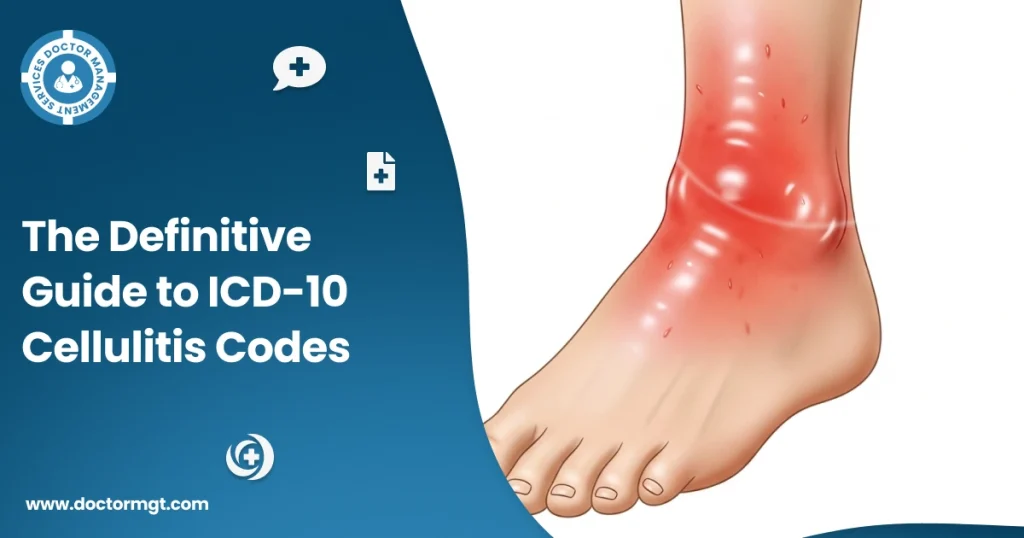If you work in healthcare, you’ve most probably seen cellulitis patients more often than you can count. It’s one of the most common skin infections treated by healthcare physicians or dermatologists, and yet, medical billing denials and delayed reimbursement are among the most common problems faced by dermatologists due to inaccurate and improper coding.
In this blog, you will understand cellulitis in the coding context, explore ICD-10 cellulitis codes, understand what documentation matters, and ensure smoother billing outcomes. Are you doing your own coding and billing or dealing with an overburdened in-house staff? This may be the information you are looking forward to.
Understanding Cellulitis in a Clinical and Coding Context
Cellulitis is a common bacterial skin condition that can be rather dangerous. It impacts the dermis and subcutaneous tissue, which are the skin’s deeper layers. Most often, streptococcus and staphylococcus bacteria enter the body through a break or fissure in the skin, causing the illness. It normally appears red or hot, swollen, and tender.
In terms of codes, cellulitis is in ICD-10 Chapter XII: Diseases of the skin and subcutaneous tissue, and the collection of codes of the cellulitis belongs to L03.0-L03.9. The thing is that a clinical diagnosis may be quite obvious, but the billing of it is not. Without proper documentation of the affected area and the omission of comorbidities, the claims will get denied or underpaid.
The Most Common ICD-10 Codes for Cellulitis:
Cellulitis can affect any part of the body; it doesn’t care. Because of this, the ICD-10 categorization for this illness is very particular, depending on the precise site of the infection. To make this process clearer, we should consider the most applicable ICD-10 codes that are used when reporting the case of cellulitis. Both of them are unique to the involved sites of the anatomy.
| ICD-10 Code | Description |
| L03.115 | Cellulitis of the right lower limb |
| L03.116 | Cellulitis of the left lower limb |
| L03.90 | Cellulitis, unspecified |
| L03.211 | Cellulitis of the face |
| L03.311 | Cellulitis of the abdominal wall |
When using a code, it is always important to note the location and laterality. An unspecified note, such as cellulitis of the leg, is uninformative; for example, was it the right or the left leg? Was it a diabetic patient? Is it a pre-existing condition?
The more detailed your documentation, the easier it will be to apply the most appropriate ICD-10 code as well as to prove the medical necessity of treatment and services provided and billed.
Key Elements Providers Must Document:
Incorrect coding can result in denials, so there are some important things to record in the patient’s chart:
- You should always document the anatomical site of cellulitis in detail, for example, if it’s in the right leg or face.
- Laterality, when applicable.
- If there is a Presence of an abscess or wound, it should be mentioned.
- Any other associated conditions, such as diabetes or immune compromise.
- If there is any History of surgical intervention or procedure in that area, it should be mentioned clearly.
Consider that a patient happens to have cellulitis of the left leg after a surgical treatment. Then the post-surgical status should also be mentioned in your documentation. The appropriate supplementary code would be Z98.890 diagnosis code, in order to indicate such context.
The other case: A patient known to have a hypothyroid condition acquires cellulitis. Then, code E03.9, the ICD-10 code of unspecified hypothyroidism, as wound-healing is being impacted.
Coding Comorbidities: Why They Matter:
When cellulitis occurs by itself, it is very rare. In most cases, it is a side problem or complication of patients with chronic illnesses. Some of the related codes that may occur are the following, depending on the overall clinical situation:
- D72.829: It is used to code Leukocytosis, which helps justify the severity or need for IV antibiotics.
- Z91.89: This is code for a Polypharmacy case, and is useful in treating geriatric patients or those on immunosuppressants.
- E11.69: It is used to represent type 2 diabetes with other specified complications.
- Z98.890: post-surgical status essential if cellulitis develops at an operative site.
Each of these codes adds detail to your patient’s condition, supports medical necessity, and strengthens your billing claim.
Common Mistakes in Cellulitis Coding and How to Avoid Them
We have already talked about the importance of proper and accurate coding. It is time to discuss accidents that can happen with even experienced coders and providers being involved. The following are some of the most common cellulitis coding errors:
- You can only use L03.90 if the site is unspecified. However, most of the coders make mistakes by using L03.90, even when the site is documented in the record
- Most of the time, coders don’t mention comorbidity codes, which can affect the risk-adjusted payments.
- Another coding mistake is not linking cellulitis to post-op conditions or if the patient has diabetic wounds.
- Regular update of the document is necessary; failure to update documentation when cellulitis spreads or worsens can lead to reduced payment or claim denial.
These mistakes may seem small, but over time, they can result in revenue loss and compliance risks.
When It’s Time to Consider Outsourcing?
Let’s be honest. When your in-house staff is shifting between taking care of your patients, charting, and billing, there will be errors. Cellulitis might not be a complex case, but you have just learned that this can quickly expand to several codes, documentation details, and billing channels.
This is the reason why numerous providers with high volumes, or practices with multiple disciplines, are approaching medical billing services California-based providers. Besides the knowledge on coding across disciplines, they also keep up with current changes on CMS, and edits that are particular to payers. The following are the key benefits of outsourcing your billing for cases like cellulitis:
- It helps reduce claim denials caused by the lack of specificity of the disease.
- Medical billing experts easily catch under-documented comorbidities that are affecting your reimbursement.
- It removes your administrative burden, which makes you focus on treating your patients instead.
- Medical billing experts are up to date with complaints, so they ensure compliance with updates to both CPT and ICD-10 standards
It is not about outsourcing the responsibility; it is about getting a partner that you can rely on. Medical billing experts have an understanding of both sides of the house, the clinical and the coding side.
Final Thoughts
Cellulitis happens to be a really common diagnosis to make, but careless inaccuracies in its coding can cost you big. Failing to mention laterality or missing a comorbidity with relevance to the patient, such errors might not be significant, but their repercussions can be.
With healthcare moving toward value-based reimbursements and quality assessment, documentation is key, especially in the accurate, detailed, and timely nature of documentation. Getting to know ICD-10 cellulitis codes and corresponding CPTs and modifiers can help you improve your revenue and even make patient care better.
Do you want to stop having headaches with billing, inconsistency with coding, or simply have a second set of eyes to look at a complex case like these? It may be time to consider professional dermatology medical billing support. Well, your role is to cure. Our job is to ensure that you will receive payment for them appropriately and in a timely manner.







